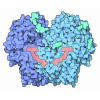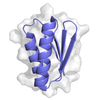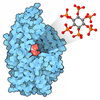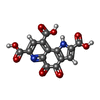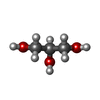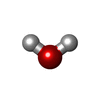[English] 日本語
 Yorodumi
Yorodumi- PDB-1c9u: CRYSTAL STRUCTURE OF THE SOLUBLE QUINOPROTEIN GLUCOSE DEHYDROGENA... -
+ Open data
Open data
- Basic information
Basic information
| Entry | Database: PDB / ID: 1c9u | ||||||
|---|---|---|---|---|---|---|---|
| Title | CRYSTAL STRUCTURE OF THE SOLUBLE QUINOPROTEIN GLUCOSE DEHYDROGENASE IN COMPLEX WITH PQQ | ||||||
 Components Components | SOLUBLE QUINOPROTEIN GLUCOSE DEHYDROGENASE | ||||||
 Keywords Keywords | OXIDOREDUCTASE / BETA-PROPELLER / SUPERBARREL / COFACTOR BINDING | ||||||
| Function / homology |  Function and homology information Function and homology informationglucose 1-dehydrogenase (PQQ, quinone) / quinoprotein glucose dehydrogenase activity / metal ion binding Similarity search - Function | ||||||
| Biological species |  Acinetobacter calcoaceticus (bacteria) Acinetobacter calcoaceticus (bacteria) | ||||||
| Method |  X-RAY DIFFRACTION / X-RAY DIFFRACTION /  SYNCHROTRON / Resolution: 2.2 Å SYNCHROTRON / Resolution: 2.2 Å | ||||||
 Authors Authors | Oubrie, A. / Rozeboom, H.J. / Dijkstra, B.W. | ||||||
 Citation Citation |  Journal: EMBO J. / Year: 1999 Journal: EMBO J. / Year: 1999Title: Structure and mechanism of soluble quinoprotein glucose dehydrogenase. Authors: Oubrie, A. / Rozeboom, H.J. / Kalk, K.H. / Olsthoorn, A.J. / Duine, J.A. / Dijkstra, B.W. #1:  Journal: J.Mol.Biol. / Year: 1999 Journal: J.Mol.Biol. / Year: 1999Title: The 1.7 Angstrom crystal structure of the apo form of the soluble quinoprotein glucose dehydrogenase from Acinetobacter calcoaceticus reveals a novel internal sequence repeat Authors: Oubrie, A. / Rozeboom, H.J. / Kalk, K.H. / Duine, J.A. / Dijkstra, B.W. | ||||||
| History |
|
- Structure visualization
Structure visualization
| Structure viewer | Molecule:  Molmil Molmil Jmol/JSmol Jmol/JSmol |
|---|
- Downloads & links
Downloads & links
- Download
Download
| PDBx/mmCIF format |  1c9u.cif.gz 1c9u.cif.gz | 200.4 KB | Display |  PDBx/mmCIF format PDBx/mmCIF format |
|---|---|---|---|---|
| PDB format |  pdb1c9u.ent.gz pdb1c9u.ent.gz | 158.3 KB | Display |  PDB format PDB format |
| PDBx/mmJSON format |  1c9u.json.gz 1c9u.json.gz | Tree view |  PDBx/mmJSON format PDBx/mmJSON format | |
| Others |  Other downloads Other downloads |
-Validation report
| Summary document |  1c9u_validation.pdf.gz 1c9u_validation.pdf.gz | 1 MB | Display |  wwPDB validaton report wwPDB validaton report |
|---|---|---|---|---|
| Full document |  1c9u_full_validation.pdf.gz 1c9u_full_validation.pdf.gz | 1.1 MB | Display | |
| Data in XML |  1c9u_validation.xml.gz 1c9u_validation.xml.gz | 47.9 KB | Display | |
| Data in CIF |  1c9u_validation.cif.gz 1c9u_validation.cif.gz | 64.5 KB | Display | |
| Arichive directory |  https://data.pdbj.org/pub/pdb/validation_reports/c9/1c9u https://data.pdbj.org/pub/pdb/validation_reports/c9/1c9u ftp://data.pdbj.org/pub/pdb/validation_reports/c9/1c9u ftp://data.pdbj.org/pub/pdb/validation_reports/c9/1c9u | HTTPS FTP |
-Related structure data
- Links
Links
- Assembly
Assembly
| Deposited unit | 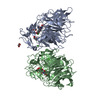
| ||||||||
|---|---|---|---|---|---|---|---|---|---|
| 1 |
| ||||||||
| Unit cell |
|
- Components
Components
| #1: Protein | Mass: 50293.207 Da / Num. of mol.: 2 Source method: isolated from a genetically manipulated source Source: (gene. exp.)  Acinetobacter calcoaceticus (bacteria) / Cellular location: PERIPLASM / Production host: Acinetobacter calcoaceticus (bacteria) / Cellular location: PERIPLASM / Production host:  #2: Chemical | ChemComp-CA / #3: Chemical | #4: Chemical | ChemComp-GOL / #5: Water | ChemComp-HOH / | Has protein modification | Y | |
|---|
-Experimental details
-Experiment
| Experiment | Method:  X-RAY DIFFRACTION / Number of used crystals: 1 X-RAY DIFFRACTION / Number of used crystals: 1 |
|---|
- Sample preparation
Sample preparation
| Crystal | Density Matthews: 2.64 Å3/Da / Density % sol: 53.48 % | ||||||||||||||||||||||||||||||
|---|---|---|---|---|---|---|---|---|---|---|---|---|---|---|---|---|---|---|---|---|---|---|---|---|---|---|---|---|---|---|---|
| Crystal grow | Temperature: 293 K / Method: vapor diffusion, hanging drop / pH: 9.2 Details: PEG 6000, SODIUM CHLORIDE, CALCIUM CHLORIDE, TRIS, GLYCINE, pH 9.2, VAPOR DIFFUSION, HANGING DROP, temperature 293K | ||||||||||||||||||||||||||||||
| Crystal grow | *PLUS | ||||||||||||||||||||||||||||||
| Components of the solutions | *PLUS
|
-Data collection
| Diffraction | Mean temperature: 100 K |
|---|---|
| Diffraction source | Source:  SYNCHROTRON / Site: SYNCHROTRON / Site:  ESRF ESRF  / Beamline: BM02 / Wavelength: 0.9488 / Beamline: BM02 / Wavelength: 0.9488 |
| Detector | Type: CUSTOM-MADE / Detector: CCD / Date: Sep 7, 1997 |
| Radiation | Protocol: SINGLE WAVELENGTH / Monochromatic (M) / Laue (L): M / Scattering type: x-ray |
| Radiation wavelength | Wavelength: 0.9488 Å / Relative weight: 1 |
| Reflection | Resolution: 2.13→39.9 Å / Num. all: 60474 / Num. obs: 48621 / % possible obs: 80.4 % / Observed criterion σ(F): 0 / Observed criterion σ(I): 0 / Redundancy: 3.7 % / Biso Wilson estimate: 29.8 Å2 / Rmerge(I) obs: 0.067 / Net I/σ(I): 8.6 |
| Reflection shell | Resolution: 2.13→2.16 Å / Redundancy: 1.6 % / Rmerge(I) obs: 0.22 / % possible all: 22.2 |
| Reflection shell | *PLUS % possible obs: 22.2 % |
- Processing
Processing
| Software |
| ||||||||||||||||||||||||||||||||||||||||||||||||||||||||||||
|---|---|---|---|---|---|---|---|---|---|---|---|---|---|---|---|---|---|---|---|---|---|---|---|---|---|---|---|---|---|---|---|---|---|---|---|---|---|---|---|---|---|---|---|---|---|---|---|---|---|---|---|---|---|---|---|---|---|---|---|---|---|
| Refinement | Resolution: 2.2→20 Å / σ(F): 0 / σ(I): 0 / Stereochemistry target values: ENGH & HUBER
| ||||||||||||||||||||||||||||||||||||||||||||||||||||||||||||
| Refinement step | Cycle: LAST / Resolution: 2.2→20 Å
| ||||||||||||||||||||||||||||||||||||||||||||||||||||||||||||
| Refine LS restraints |
|
 Movie
Movie Controller
Controller


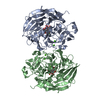



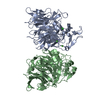
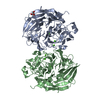
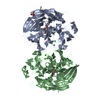
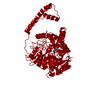
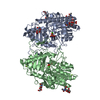
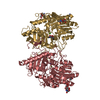
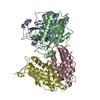


 PDBj
PDBj